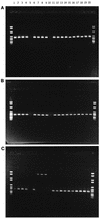Molecular analysis of Tn1546 in Enterococcus faecium isolated from animals and humans
- PMID: 9466754
- PMCID: PMC104555
- DOI: 10.1128/JCM.36.2.437-442.1998
Molecular analysis of Tn1546 in Enterococcus faecium isolated from animals and humans
Abstract
The internal areas and the position of integration of the glycopeptide resistance element Tn1546 were characterized by using PCR fragment length polymorphism, sequencing, and DNA hybridization techniques with 38 high-level vancomycin-resistant Enterococcus faecium isolates of human and animal origins from Europe and the United States. Only minor variations in the coding regions within Tn1546 were found, suggesting high genetic stability. The isolates originated from broilers (n = 5), a chicken (n = 1), a duck (n = 1), a turkey (n = 1), pigs (n = 8), a pony (n = 1), and humans (n = 23). A total of 13 different types were defined based on a single-nucleotide difference in the vanX gene, the presence of insertion sequences, and hybridization patterns. For some types more than one isolate were found. For type 1, 10 isolates of both human and animal origins were found. All were indistinguishable from the reference strain, BM4147. For type 2, 11 isolates of human and animal origins were found. Six human isolates from England were all of type 3. Two human isolates from the United States, indistinguishable from each other, were type 9. These results showed that vancomycin-resistant E. faecium of animal and human origins can contain indistinguishable genetic elements coding for vancomycin resistance, indicating either horizontal gene transfer between E. faecium organisms of human and animal origins or the existence of a common reservoir for glycopeptide resistance.
Figures


References
-
- Aarestrup F M, Ahrens P, Madsen M, Pallesen L V, Poulsen R L, Westh H. Glycopeptide susceptibility among Danish Enterococcus faecium and Enterococcus faecalis isolates of animal and human origin and PCR identification of genes within the VanA cluster. Antimicrob Agents Chemother. 1996;40:1938–1940. - PMC - PubMed
-
- Aarestrup F M. Occurrence of glycopeptide resistance among Enterococcus faecium isolates from conventional and ecological poultry farms. Microb Drug Resist. 1995;1:255–257. - PubMed
MeSH terms
Substances
LinkOut - more resources
Full Text Sources
Medical

